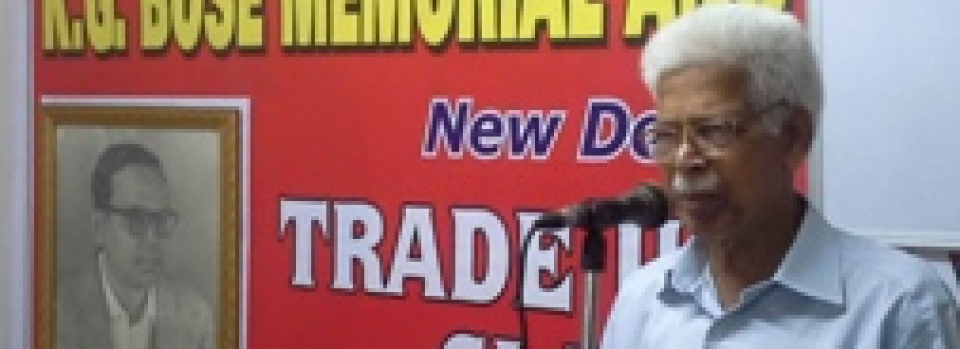HAPPY AND SATISFIED (MY LIFE STORY)- 2
DISINTEGRATION OF THE DECAYED SOCIAL SYSTEM
Social systems and practices are born out of necessity, or forced by the powers that be at that particular period of time. Sometimes due to compulsion or by pressure of the new emerging forces, they change for the better.
The Independence Struggle, the Second World War (1942 – 46), the tragic famine which took away crores of lives and the Independence itself resulted in a lot of changes in the country. The decayed old social system based on the Brahminic order was certain to be changed and that is exactly what happened. But the disintegration took many years to take place.
Social reforms had started in Kerala much earlier. Sree Narayana Guru, Ayyankali, Sahodaran Ayyappan, Pandit Karuppan, Vagbhadanandan and many other great personalities have initiated the process of renaissance and strong movement against untouchability, religious superstitions, obnoxious practices, social stigma and so on. The influence of Gandhiji had spread all over the country.
Within the Namboodiri community itself, a strong movement arose under the leadership of V.T.Bhattathiripad, Premji, E.M.S.Namboodiripad and many other youngsters who wanted the namboodiris to wake up from the somnambulism in which the community was lying for decades. The anacharams or obnoxious practices like child marriage, polygamy, lack of modern education, darkness of the kitchen where the women were almost closeted – all had to be changed to convert the Brahmin to a normal human being. School education was necessary. The struggle was intense between the die-hards of the old order and the youngsters of the new order. It was in such changing times that I was born and had my early days.
Com.E.M.S.Namboodiripad in his autobiography has explained in detail the difficult and tragic situation in which the Namboodiri women, children etc. had to live. In a more or lesser way, all these decayed and obnoxious systems continued in our area also.
Since there were no Namboodiri families very near to our home, we used to play with children belonging to other castes. Whenever we had to enter home, take food etc. we had to take bath having played with children of other castes. When we go to the temples or to the house of relatives through the narrow path in the paddy fields, people belonging to certain castes have not only to give way, but keep away themselves for a particular defined distance. Kerala was a bhrantalaya in this respect, as Swami Vivekananda had stated.
Women, including anterjanams, were not allowed to wear blouse when entering the temple but can only cover themselves with some piece of cloth or bath towel. There was discrimination in taking bath in the temple tank. There were two ghats covered with thatched roof, one for Namboodiris and the other for anterjanams. Others, women as well as men, were to take bath in open ghats. Discrimination existed almost in all matters.
My mother was comparatively liberal and not very strict in observing these obnoxious practices. She would go to other Brahmin homes alone, of course with the marakkuda (umbrella made of palm leaves and bamboo handle used by anterjanams whenever going out of home). She used to work with the servants in husking the paddy as well as performing other domestic chores. She used to look after the children in a very caring way.
Till being admitted to the school, there was no tuition or coaching as is the system now. No LKG or such pre-admission classes. The education starts after admission to the first standard in the school. Of course, the children will be initiated to education on Vijaya Dashami by the parent or Guru writing with a gold ring on the tongue of the child. This system is still observed not only by Brahmins, but by all, irrespective of castes.
Everyday mother used to read the Maha Bhagavatham for some time and I used to sit nearby. Mother will explain, whenever there is a story in it. In the Karkkidaka Month, Ramayana also will be read.
My eldest brother Kesavan Namboodiri was working as a teacher near Cannanore. He was a Gandhian and used to wear only khadi. At that time khadi dhoti, shirts etc were not for sale. One had to spin thread from the Charkha and the bundles of thread will have to be given to the Khadi Sarvodaya Sangh. They will send it to the Payyanur weaving unit and the woven cloth / dhoti will be supplied after they are ready. Even the coolie charges will have to be given in yarn. It took about one month to get the same. Mother, sisters and we all knew how to spin thread. Two- three charkhas were in our house. Purchasing of the cotton bundles, cleaning it, making it in to spindles and then spinning – all were tedious work, but had to be done so that eldest brother can get khadi clothes to wear. (to be continued)
Photoes (1) Father Shri V.A.Kesavan Namboodiri (2) Mother Smt. V.A.Sreedevi Anterjanam.


<img class="j1lvzwm4" src="data:;base64, ” width=”18″ height=”18″ />
<img class="j1lvzwm4" src="data:;base64, ” width=”18″ height=”18″ />
<img class="j1lvzwm4" src="data:;base64, ” width=”18″ height=”18″ />
